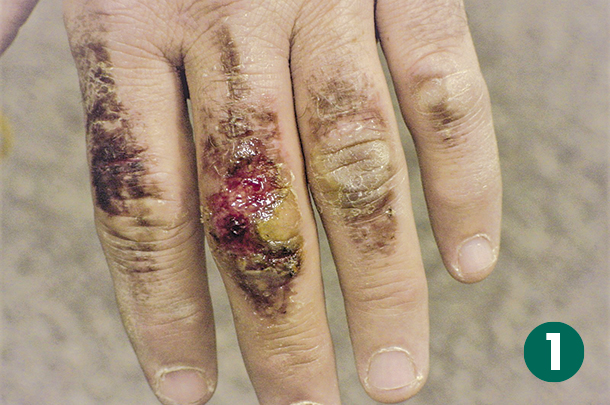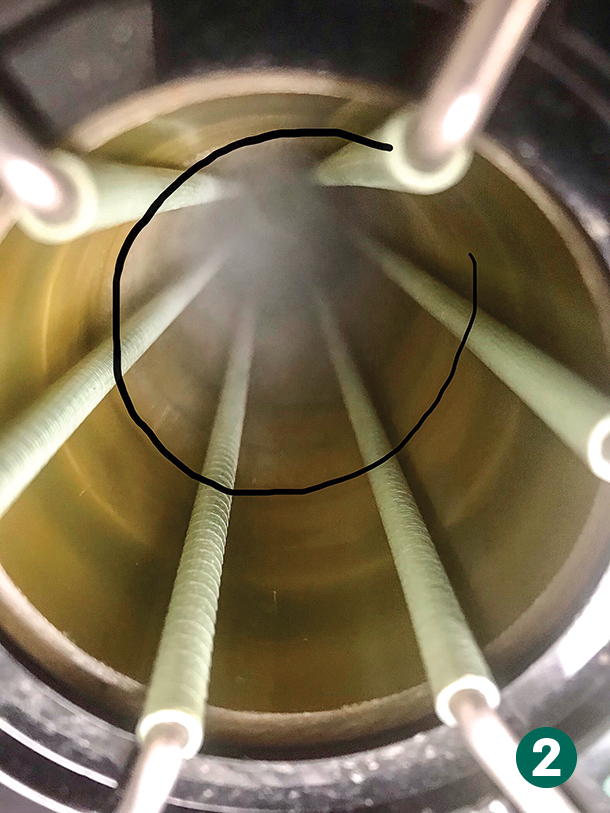Success rates with artificial insemination (A.I.) are affected by many different things. Condition of the cattle, plane of nutrition, number of days postpartum for lactating cows, heat detection, semen handling and technician skill level are all important factors.
Some techniques may vary from inseminator to inseminator, which is acceptable as long as all major rules for proper semen handling are adhered to.
This article will focus on recommended semen-handling practices.
First, use caution when handling the semen tank. The temperature of liquid nitrogen is -320ºF and can cause burns with exposure to the skin. Photo 1 shows liquid nitrogen burns suffered by a friend who was wearing cotton gloves while transferring semen from one tank to another. Liquid nitrogen was accidentally spilled on a glove my friend was wearing.

Bovine semen, whether frozen or thawed, is adversely affected by temperature fluctuation. Canisters and canes of semen should be kept below the frost line in the neck of the tank (see Photo 2).

If lifted above the frost line for more than a few seconds, the frozen straws may begin to warm up enough to form ice crystals inside even though they don’t completely thaw. Ice crystals cause damage by cutting off the tails of sperm cells and causing other physical damage. If you have trouble when removing a frozen straw from the semen tank, the best practice is to lower the canister back into the tank and start the process over again. This will protect the remaining straws in the canister. Learning to properly use semen straw tweezers can protect your fingers from the cold and allow you to reach farther down into the neck of the tank when removing a semen straw.
While the industry standard for many years has been the 1/2-cc straw, some A.I. companies have gone entirely to 1/4-cc straws for all future collections and freezing. It is rumored that 1/2-cc straws will be phased out over time. With 1/4-cc straws, it is even more critical to follow recommended handling procedures, as 1/4-cc straws are more sensitive to post-thaw temperature changes.
Thawing semen
It is recommended that a warm-water thaw be used when thawing semen. Quickly take the semen straw from the tank and place it gently in the thaw water. Most U.S. semen companies recommend a thawing temperature of 94ºF to 98ºF. Use a thermometer to ensure proper thaw-water temperature. Semen-thawing units should be checked regularly to be sure they are operating at the proper temperature. Thaw water that is too cool will delay the thawing process, which can cause ice crystal formation and sperm cell damage.
No more than three straws should be thawed at one time to ensure that the frozen straws themselves do not cool the thaw water and delay the thawing process. With multiple breeders and the use of a breeding box, it may be advisable to utilize two thaw boxes to ensure that proper temperature is maintained. Thaw water that is too hot can kill or damage sperm cells. Semen straws should be left in the thaw water for a minimum of 45 seconds.
When breeding large groups of animals, it may be advisable to have one individual do all of the thawing and loading of guns. This will allow that person to solely focus on following proper procedures, can help maintain good sanitation and better manage tank inventory.
Warm the A.I. gun and disposable sheath. Remove the semen straw from the thaw water and dry it thoroughly with a paper towel. Be sure to protect it from UV light and temperature change. Verify that you have thawed the correct semen. Cut the crimped end of the straw using a Cito cutter or scissors (see Photo 3).

Load the straw into the sheath and gun using your preferred method, again taking care to protect it from temperature change. Place the now-loaded A.I. gun inside your shirt, coveralls or in a gun warmer and go to the cow. Be sure to take an A.I. sleeve and some paper towels with you.
At the cow
Use paper towels to gently clean the vulva. Avoid excessive pressure that may actually push manure inside the vulva. Open the lips of the vulva and insert the A.I. gun, using one smooth motion to remove it from your coveralls, shirt or gun warmer. Then complete the insemination process. For best conception results, no more than 10 minutes should pass from thawing to insemination. When breeding multiple cows and thawing multiple semen straws at once, the 10-minute rule still applies. You should not thaw more semen than the number of cows you can inseminate within 10 minutes. Semen may still be viable beyond 10 minutes post-thaw; however, fertility will begin to decline.
Summary
Successful A.I. is very dependent on following recommended semen-handling practices. By paying careful attention to minimizing temperature fluctuation and the time from thawing to insemination, inseminators will increase the number of A.I.-sired calves born. ![]()
Photos provided by Scott Jensen.

-
Scott Jensen
- Extension
- University of Idaho – Owyhee County Extension
- Email Scott Jensen
MORE RESOURCES
For additional tips on semen handling, review this training poster at the Progressive Cattle website: Semen handling tips.








